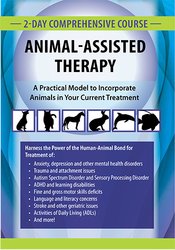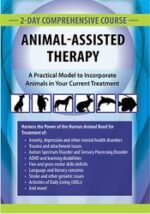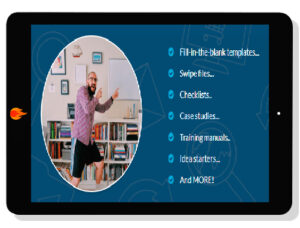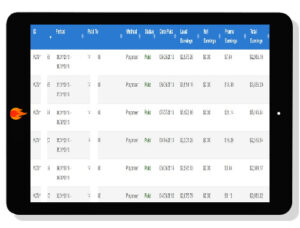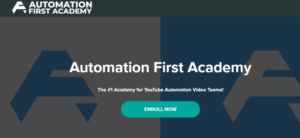(This course is available for immediate delivery) AAT improves treatment outcomes in a wide variety of fields, including mental health, speech and language pathology, occupational therapy, physical therapy, education and medical.
Jonathan Jordan – 2-Day Certificate Course in Animal-Assisted Therapy
Watch this certificate course recording in Animal-Assisted Therapy (AAT) and learn a practical framework that facilitates incorporating evidence-based AAT into your current treatment methodology. You will receive specific, practical examples of how to implement AAT to greatly improve treatment outcomes for children, adolescents, adults, and geriatric client outcomes in a surprisingly broad range of areas, including:
Reduce stress and anxiety and lower blood pressure
Lessen symptoms of depression and loneliness
Enhance mindfulness and attachment
Lessen the effects of trauma and PTSD
Improve human-to-human social functioning
Help people suffering from agoraphobia
Improve sensory recognition in people recovering from a stroke
Help individuals with learning disabilities and speech and language deficits
Improve Activities of Daily Living (ADLs)
Assist addicts to remain clean and sober
Increase feelings of acceptance and belonging
And More!
You will receive resources to help you immediately implement your own AAT program, including how to select a therapy animal, tools to assess for the animal’s temperament, limitations and stress levels, and how to include AAT on a treatment plan and document it in the progress notes. Learn the latest research outcomes, solid neuroscience about the human-animal emotional bond and information about relevant laws.
AAT improves treatment outcomes in a wide variety of fields, including mental health, speech and language pathology, occupational therapy, physical therapy, education and medical.
Utilize the KADRA Model to incorporate animals in your current treatment to improve clinical outcomes.
Summarize the role of animals in enhancing mindfulness in humans to help reduce symptomology.
Explain the difference between a therapy animal and a service animal as it relates to clinical treatment.
Describe the difference between the roles of the animal handler and the treatment provider in a therapeutic setting.
Summarize the research related to clinical outcomes of Animal-Assisted Therapy as it relates to assessment and treatment planning.
Implement Animal-Assisted Therapy (AAT) interventions to reduce symptoms of trauma, stress, anxiety and depression in clients.
Develop AAT interventions to treat deficits and disabilities related to speech-language pathology, occupational therapy and physical therapy.
Construct a comprehensive treatment plan that incorporates AAT interventions to improve clinical outcomes.
Differentiate between the major federal laws that impact AAT to inform clinical treatment.
Articulate the definition of Animal-Assisted Therapy and how it differs from other animal-assisted interventions.
Implement three different types of AAT that are included in the KADRA Model.
Present specific attributes and characteristics to identify when choosing a suitable therapy animal for AAT.
Would you like to receive Jonathan Jordan – 2-Day Certificate Course in Animal-Assisted Therapy ?
A Framework to Harness the Power of the Human-Animal Bond in Treatment
The KADRA Model of Animal-Assisted Interventions
Incorporate AAT with other evidence-based therapies
The major categories of AAT
Mindfulness of Animals – Help Humans Thrive Not Just Survive
The neuroscience of the human-animal emotional bond
Why zebras don’t get ulcers
How animals help us overcome trauma
The Incredible Range of Therapeutic Benefits in Animal-Assisted Therapy (AAT)
Evidence-based research and outcomes
Therapy animals, service animals and emotional support animals
Disorders that respond well to AAT
Enhance the therapeutic relationship
Limitations and potential risks
PRACTICAL APPLICATION OF THE KADRA MODEL
Treatment Planning and Goals
How to include AAT on a treatment plan
How to document AAT in progress notes
What you need to know about billing
Considerations for closure
Interaction techniques for client and animal
Practical Examples/Case Studies of AAT for:
Mental, Emotional and Behavioral Disorders
Trauma and PTSD
Anxiety and depression
Attachment
Conduct Disorders
Autistic Spectrum Disorder
ADHD
Social-emotional regulation
Loneliness and self-esteem
Speech-Language and Learning Disabilities
Dyslexia
Language and literacy
Vocabulary improvement
Increase verbal interactions and communication
Physical and Occupational Issues
Fine and gross motor skills
Standing balance
Stroke and geriatric issues
Sensory processing
Activities of Daily Living (ADLs)
Start Your Own Animal-Assisted Program
How to choose your therapy animal: Qualifications and characteristics
Common and less common animal species involved in treatment
Dog training basics
Protocol for introducing animal and client
Organizations and resources
Here’s What You’ll Get in Jonathan Jordan – 2-Day Certificate Course in Animal-Assisted Therapy

